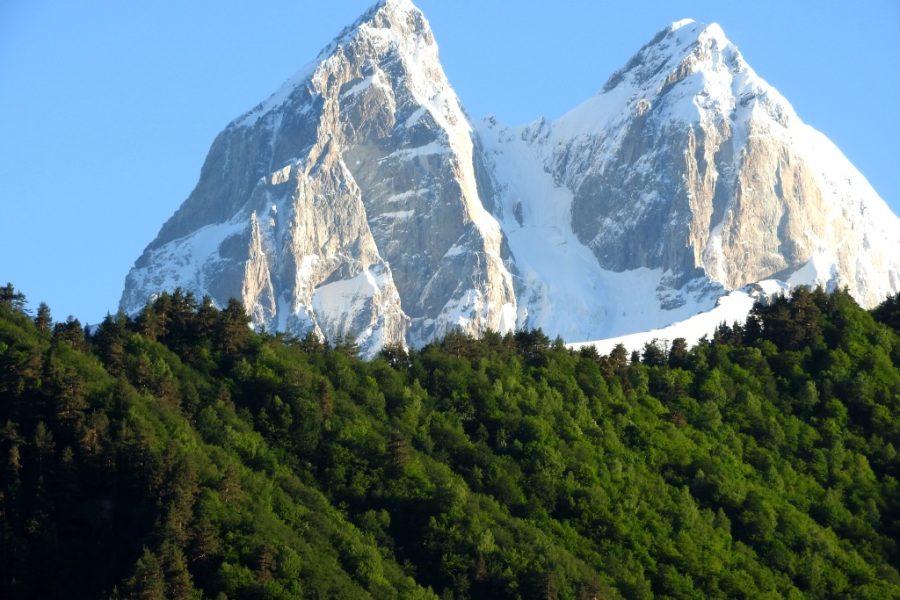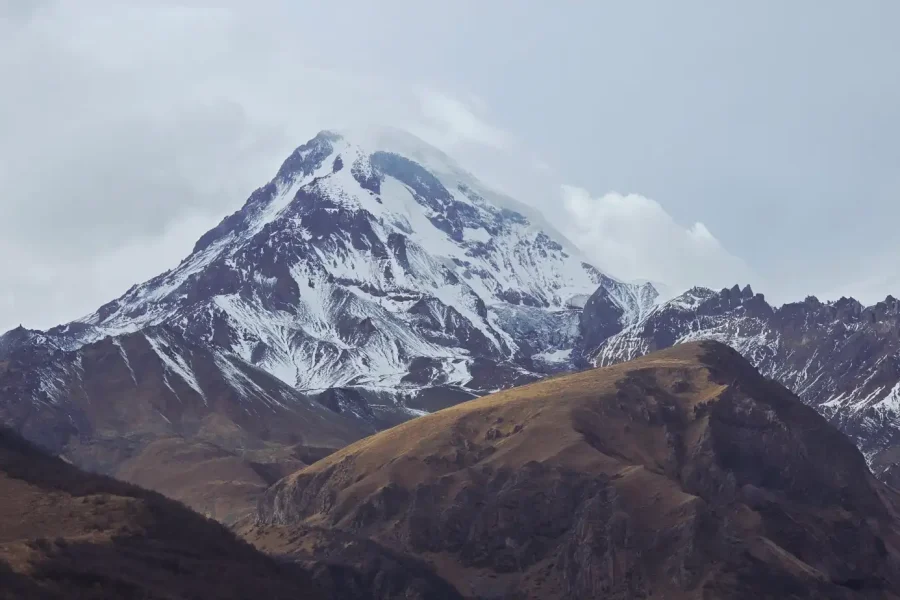Tusheti State Nature Reserve: A Core of Untouched Wilderness
The Tusheti State Nature Reserve is the most protected part of the Tusheti Protected Areas complex. It is in the Akhmeta Municipality in Georgia’s Kakheti region. This reserve is one of the most beautiful and untouched high-mountain areas in Georgia and even in Europe. It is located high in the Greater Caucasus mountains along Georgia’s northeastern border with Russia (Chechnya and Dagestan). Its main goal is to protect the unique natural ecosystems and biodiversity of the upper Caucasus, such as native plants and animals, unique pine forests, alpine meadows, and important habitats for rare species like the East Caucasian Tur.
A Sanctuary for Science and Nature
Tusheti SNR is a State Nature Reserve and has the highest level of protection, which is the same as IUCN Category Ia (Strict Nature Reserve). This means that there is no public access to any recreational activities or tourism. The main goal of the reserve is to let natural ecological and evolutionary processes happen with as little human interference as possible. This makes it an important place for baseline environmental monitoring and scientific research. In stark contrast to the nearby Tusheti National Park and Tusheti Protected Landscape zones, regulated tourism, traditional land use (like sheep grazing), and living in historic settlements are all allowed and controlled.
Landscape of the High Caucasus
The reserve is made up of rough terrain with high mountains, steep slopes, deep river gorges (which are probably the headwaters of the Pirikiti and Tushetis/Gometsris Alazani rivers), high-altitude plateaus, alpine meadows above the tree line, and maybe remnants of glaciers or permanent snowfields on the highest ridges. The elevation is probably over 3000 meters in many places. The climate is harsh, with long, cold winters with a lot of snow and short, cool summers. This environment has a lot of different types of animals, like the East Caucasian Tur, Chamois, Brown Bear, Wolf, and Lynx, as well as birds that live at high altitudes, like the Caucasian Snowcock and Caucasian Black Grouse. The plants are just as strange, with patches of high-mountain pine trees, rhododendron thickets, and a wide range of alpine wildflowers, most of which are native to the Caucasus.
The Tusheti Protected Areas Administration, which is part of Georgia’s Agency of Protected Areas, runs the reserve. It has problems with being cut off from the rest of the world, possible poaching pressure, climate change’s effects on fragile alpine ecosystems, and keeping its boundaries. It is valuable because it serves as a non-intervention reference area and an important sanctuary for high-mountain biodiversity in the culturally and ecologically important region of Tusheti.
Reserve Overview at a Glance
Official Name:
Tusheti State Nature Reserve. Tusheti National Park and Tusheti Protected Landscape are two other parts of the Tusheti Protected Areas.
Protected Area Type:
State Nature Reserve (IUCN Category Ia – Strict Natural Reserve).
Established:
Established in 2003 as part of the Tusheti Protected Areas system.
Managing Body:
Georgia’s Agency of Protected Areas is in charge of the government.
Location and Access Restrictions
Location:
The Akhmeta Municipality is in the Kakheti area of Georgia, which is in the Tusheti historical-geographical region. Located in the high peaks of the Greater Caucasus mountains, next to the Russian Federation (Republics of Chechnia and Dagestan).
Map/Coordinates:
The Tusheti Protected Areas are located between 42°20′ and 42°35′ N and 45°15′ and 45°50′ E. The reserve is located within these coordinates. Official maps show the exact boundaries of the strict reserve zone.
Closest Towns/Access Point:
The town of Akhmeta, which is further down in the Kakheti lowlands, is the administrative center. The seasonal Abano Pass (about 2850m) is the only way to get to the Tusheti region. It is usually open from June to September/October and requires a 4WD vehicle. You can start exploring the protected areas from Tusheti villages like Omalo and Dartlo.
How to Get There:
It is hard to get to the Tusheti area and it only happens at certain times of the year. The Tusheti State Natural Reserve zone is completely off-limits to the general public. Only people with special permits from the Agency of Protected Areas can go there for certain scientific study purposes.
Landscape and Geography
Area:
About 12,500 hectares (125 km²), which makes it a significant core zone within the larger Tusheti Protected Areas system.
Topography:
High mountains with steep slopes, deep river gorges, high peaks, cirques, and alpine plateaus. The highest peaks in the nearby ranges are probably between 1500m and 4000m high, either inside or near the reserve.
Geology and Key Features:
Part of the Greater Caucasus fold system, it is mostly made up of shales, sandstones, and other sedimentary rocks. Evidence consists of glacial landforms such as cirques, moraines, and trough valleys.
Hydrology:
Includes the headwaters and upper catchments of many mountain rivers and streams that make up the Pirikiti Alazani and Tushetis (Gometsris) Alazani river systems. There could be small glacial lakes at high altitudes.
Climate:
A very harsh climate in the high mountains. The area was cut off by long, very cold, snowy winters. Summers are short and nice, especially at higher altitudes. The weather is a little unpredictable and can change quickly.
Purpose and Significance
Reason for Designation:
Strict protection of the pristine and representative high-mountain ecosystems of the Eastern Greater Caucasus. This includes unique pine forests, alpine and subalpine meadows, and important habitats for rare and endemic plants and animals, especially ungulates like the East Caucasian Tur. To be a place where ecological monitoring and scientific research can take place without any interruptions.
Key Values:
High biodiversity, wilderness value, conservation of endemic species (e.g., Tur), protection of unique forest types (high-altitude pine), scientific reference areas, and landscape preservation are the main values.
International Recognition:
The Emerald Network includes the larger Tusheti Protected Areas, and Georgia’s Tentative List for UNESCO World Heritage designation includes the area as a combined Cultural and Natural Landscape. The area is also known as an Important Bird Area (IBA).
Biodiversity: The Reserve’s Natural World
Ecosystems and Habitats:
There are clear vertical zones: forests (mostly Scots Pine – Pinus sylvestris var. hamata, Birch – Betula spp. at the lower edges), subalpine shrublands (Caucasian Rhododendron – Rhododendron caucasicum), huge alpine meadows, scree slopes, cliffs, and nival (snow zone) habitats at the highest altitudes.
Key Plant Species:
Some of the most important plants are Scots Pine (Pinus sylvestris var. hamata), Caucasian Rhododendron (Rhododendron caucasicum), several types of Birch (Betula), Gentians, Bellflowers, Primulas, and many other alpine wildflowers, most of which are native to the Caucasus.
Key Animal Species:
- The East Caucasian Tur (Capra cylindricornis) is the most important animal species.
- Chamois (Rupicapra rupicapra caucasica), Brown Bear (Ursus arctos), Grey Wolf (Canis lupus), and Eurasian Lynx (Lynx lynx) are all present.
- There could be Bezoar Goats (Capra aegagrus aegagrus) in the reserve area, so you should check to make sure.
- Birds that live there include the Bearded Vulture (Gypaetus barbatus), the Golden Eagle (Aquila chrysaetos), the Caucasian Snowcock (Tetraogallus caucasicus), the Caucasian Black Grouse (Lyrurus mlokosiewiczi), and some mountain passerines.
Endangered/Rare Species:
The East Caucasian Tur is “near threatened,” the Bezoar Goat is “vulnerable” (if it is present), the Brown Bear, the Wolf, and the Lynx are all “vulnerable.” Bearded Vulture is close to being endangered all over the world. A lot of plants are only found in the Caucasus.
Visitor Information: Access Not Permitted
Visitor Center:
The Tusheti Protected Areas’ visitor center is in Omalo, and there is also an office in Kvemo Alvani to help. This place mostly gives information about the National Park and Protected Landscape zones. It does not let people into the Strict Nature Reserve.
Hours and Seasons:
The public is not allowed in the Strict Nature Reserve. Normally, snow on the Abano Pass makes it hard to get to the Tusheti region from June to September/October.
Entrance Fees and Permits:
You can’t go in. The Agency of Protected Areas gives out scientific permits. You have to pay to use trails and services in the National Park and Protected Landscape zones.
Trails and Routes:
There are no public paths in the Strict Nature Reserve zone. There are a lot of hiking and horseback riding trails in the area around here.
Activities:
No fun activities are allowed in the Strict Nature Reserve. Only allowed for necessary monitoring and approved scientific research. Hiking, horseback riding, cultural tourism, and birdwatching are some of the most popular things to do in the areas that are easy to get to.
Accommodation:
None inside the Strict Reserve. Settlements like Omalo, Dartlo, Shenako, and others in the National Park/Protected Landscape areas have guesthouses. Camping is allowed at certain places outside the reserve.
Facilities:
None inside the Strict Reserve.
Safety Advice:
Not important for people who come to the Strict Reserve. People who want to visit the accessible Tusheti area need to plan ahead for long trips to the mountains, changing weather, and rough terrain.
Strict Rules and Regulations
Code of Conduct:
The Code of Conduct lays out strict rules for any allowed access (scientific staff).
Prohibitions:
No one can go there, and all kinds of tourism, recreation, resource use (grazing, collecting), hunting, fishing, etc. are also banned.
Zoning:
The main IUCN Category Ia zone in the multi-zoned Tusheti Protected Areas complex.
Conservation and Management
Managing Body:
The Tusheti Protected Areas Admin. is in charge of the Agency of Protected Areas of Georgia.
Conservation Efforts:
Mainly worried about strict enforcement of the no-access policy through patrolling. Keeping an eye on important animal populations, especially Tur, and the places where they live. Steps to stop fires. Helping and overseeing approved scientific research projects. Keeping an eye on areas near places where people live and work.
Threats and Challenges:
Making sure that patrolling is effective in a large, faraway area to stop poaching, especially of Tur. Stopping people from grazing on land that isn’t theirs. Keeping an eye on and lowering the possible effects of climate change on fragile ecosystems at high altitudes. Keeping an eye on the possible pressures that could come from nearby tourism growing. Running in such a remote area is hard to plan for.
Historical and Cultural Context
A Brief History:
The contemporary protected areas complex, which includes the Strict Nature Reserve, was officially established in 2003 to fully protect Tusheti’s unique natural and cultural environment. Before this, people who cared about the environment came to the area.
Cultural Importance:
The reserve is in the Tusheti region, which is known for its unique cultural landscape, traditional architecture (stone defensive towers), distinct highland communities (the Tush people), semi-nomadic pastoralism (sheep farming and transhumance), and a mix of pagan and Christian traditions. The reserve protects animals, but it is also home to a lot of people and their culture.
Interesting Facts About Tusheti Reserve
Unique Features:
- It protects some of Europe’s and the Greater Caucasus’s most remote and untouched high-mountain wilderness areas.
- This is a very important place for the East Caucasian Tur, a species that lives in the eastern Greater Caucasus.
- Includes pine forests at high altitudes that are not common.
- Part of the larger Tusheti Protected Areas, which aims to protect both nature and a specific cultural environment.
- The opening of the high-altitude Abano Pass every year, which is one of the highest drivable passes in the Caucasus, determines who can get to the whole Tusheti area.












Leave a review